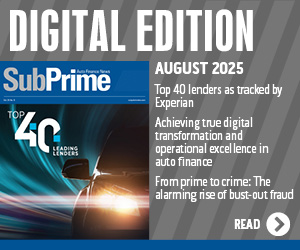Subprime auto ABS delinquency level not seen since 1996

Fitch Ratings pointed to three reasons why delinquencies on U.S. subprime auto ABS have eclipsed 2009 recessionary levels and are now at a level not seen in nearly two decades.
On Monday, analysts indicated subprime delinquencies of 60 days or more hit 5.16 percent for February reporting, marking the highest level observed since October 1996 (5.96 percent). During the most recent recession, delinquencies peaked at 5.04 percent in January 1999.
Fitch determined February’s delinquencies represented increasing of 11.63 percent year-over-year and 3.63 percent on sequential basis.
Analysts also noticed subprime annualized net losses have followed the rise in delinquencies, reaching 9.74 percent as of February, an increase of 34.10 percent year-over-year and 11.59 percent from January reporting. Despite the increase, Fitch noted annualized net losses remain below the recessionary peak of 13.14 percent experienced in February of 2009.
“Sharp origination growth, increased competition and weaker underwriting standards over the past three years have all contributed to the weaker performance of the past year,” Fitch Ratings said.
The firm recapped that subprime ABS issuance averaged a little more than $20 billion in 2013 and 2014 before ballooning to more than $25 billion a year ago, marking the highest level since 2005 and 2006.
Fitch also mentioned the number of finance companies issuing ABS also increased to 19 last year compared to the previous high of 14 in 2005 and 2006.
“Increased competition has led to increases in loan-to-value ratios and extended term lending,” analysts said. “Additionally, lenders have marginally weakened credit standards, with particular increases in originations to borrowers with no FICO scores.”
Fitch reiterated that it only rates ABS platforms sponsored by two of the larger finance companies in the subprime sector, General Motors Financial and Santander Consumer USA. Analysts mentioned cumulative net losses on their recent ABS transactions from 2013 to 2015 are rising marginally but remain well within Fitch's initial expectations.
“Enhancement growth has been strong despite slightly weakening performance and, as such, Fitch consistently upgraded subordinate bonds in 2015 and has continued to do so in 2016, thus far,” analysts said.
In contrast, Fitch highlighted performance within the prime sector remains stable, albeit slightly weaker.
Analysts indicated 60-day delinquencies stood at 0.46 percent for February reporting, up 9.27 percent on a sequential basis but flat compared to the same period a year earlier.
Fitch reported that Prime annualized net losses has increased slightly in 2016, reaching 0.69 percent for February representing an increase of 32.17 percent year-over-year.
While representing the highest level since February 2011 (0.90 percent), analysts explained losses are still “well below” the historical average of 0.92 percent and the recessionary peak of 2.23 percent in January 2009.
“Fitch considers the slight increases in losses to be more of a normalization trend within the prime sector as performance trends move away from historical lows experienced over the past five years,” analysts said.
“However, loss levels could rise further if loan-to-value ratios and extended-term lending are not adequately managed and continue to increase,” they continued.
Fitch expects both prime and subprime auto loan ABS asset performance to improve over the spring months with the onset of tax refunds.
“That said, typical seasonal benefits are likely to be more muted this year versus recent years given rising pressures on the aforementioned asset performance as well as anticipated weakness in the wholesale market,” analysts said. “Both the prime and subprime sectors have been buoyed by strong used vehicle values over the past five years, contributing to lower loss severity on defaults.”
With new-vehicle sales and expected off-lease vehicle supply levels at historical highs entering 2016, Fitch anticipates “weakness” in the wholesale market as reflected by the Manheim Used Vehicle Value Index. Manheim recently noticed the index dipped 1.4 percent in February.
“Any future declines in the Manheim Index, as well as other market indicators, will likely contribute to higher loss severity for defaults and drive losses higher,” analysts said.
Despite further weakness anticipated, Fitch continues to have a stable outlook for prime and subprime auto ABS asset and ratings performance in 2016. Analysts pointed out that annualized net losses are expected to rise at or near the 1 percent and 10 percent area for prime and subprime, respectively, “both well within peak recessionary levels.”
Fitch’s indices track the performance of $99.5 billion of outstanding auto loan ABS transactions, of which 61.68 percent is prime and the remaining 38.32 percent is subprime ABS as of February reporting.


